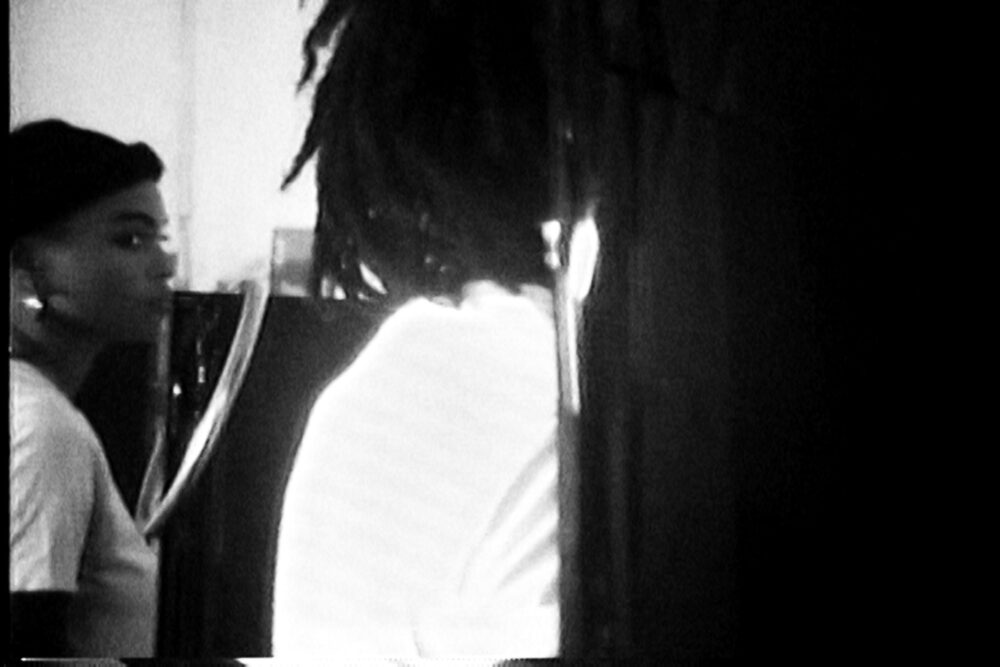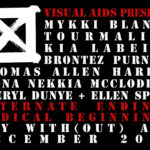Announcements
Wednesday December 27, 2017
ALTERNATE ENDINGS, RADICAL BEGINNINGS Video & Artist Statement: Tiona Nekkia McClodden

Tiona Nekkia McClodden, The Labyrinth 1.0, 2017. Still courtesy the artist.
Tiona Nekkia McClodden, The Labyrinth 1.0
ALTERNATE ENDINGS, RADICAL BEGINNINGS is the 28th annual iteration of Visual AIDS’ longstanding Day With(out) Art project. Curated by Erin Christovale and Vivian Crockett for Visual AIDS, the video program prioritizes Black narratives within the ongoing AIDS epidemic, commissioning seven new and innovative short videos from artists Mykki Blanco, Cheryl Dunye & Ellen Spiro, Tourmaline, Thomas Allen Harris, Kia LaBeija, Tiona Nekkia McClodden and Brontez Purnell.Below, Day With(out) Art artist Tiona Nekkia McClodden discusses her contribution to the program, The Labyrinth 1.0.
All seven artist statements are also printed in our Day With(out) Art 2017 publication, available here.
“The Labyrinth” is a poem that was written by Brad Johnson, published in 1995. The anthology called Milking Black Bull is one of the few publications where you can find Brad's work. The book highlights Black, gay poets who were positioned as the new guard following the significant amount of poets who died from the AIDS epidemic in the late 80s and early 90s. “The Labyrinth” is a really sexually explicit, aggressive and transgressive poem. It's one of my favorites of Brad’s. The piece deals with the labyrinth and the traditional form of the Minotaur, navigating the space of half man, half bull. The first line is “bull fucks with no smiles in the labyrinth / just teeth, wild and gnashing lust.” Brad refers to himself as the bull, which I find fascinating because it's a confrontation or his way of reclaiming that title, which has been used as a racialized term in the history of Black America to describe Black enslaved men in regards to breeding. What does it mean for a Black gay man who's not enslaved or interested in sex with women to call himself a bull, in regards to the way he navigates bathroom sex and non-traditional cruising spaces?
When people see this film, what they're looking at is a poetic essay of sorts. I happen to be interested in tearoom porn, which is bathroom porn that usually centers around either surveillance or is actually shot in a way that's very confined and is not always explicit. I wanted to source a surveillance porn, shot by police in a bathroom in the 1960's, where they were basically filming men engaging in sexual acts and treating the bathroom as if it were a crime scene. I’m also using a tearoom porn that is shot-directed with music and beautiful men who are very aware that they are being filmed. I wanted to create this confrontation of both, a collage of sorts, highlighting these suggested sexual acts from different perspectives. Then there's original footage of my actors Sara Elise and Jeremy Toussaint-Baptiste who are performing as Brad, both feminine and masculine. I think of them as my conscience, so they're in this set space that is a more controlled environment, shot on a format that suggests Brad’s more productive time, the 80's and early 90's. Thematically and formally, I'm interested in using textures of those forms of media—original footage, 16mm—to trigger that memory, as well as low resolution because you're already watching something you're not supposed to be "seeing.”
I don't want to tokenize Brad, which is why he's situated in a larger trilogy. Essex Hemphill was first for me, then Julius Eastman and here's Brad Johnson. I was interested in trying to look at three Black gay men who produced work during the AIDS epidemic or that we lost during the epidemic. What does that work look like? Essex died of complications from AIDS. With Julius, there’s not any kind of record of whether he was positive, so I don't like to play with that. But he produced work during the height of the epidemic. And Brad Johnson acquired HIV that became AIDS in 1996, but died later, in 2011. He's coming after, and it's very important that we think about that range. There was a wave that hit, and then there's these men who were friends, mentors, mentees, who lost all their peers, and were still making this work. How do you also acknowledge who they were in a sphere with? What was that space? In my work featured in Speech/Acts at ICA Philadelphia, Essex is in conversation with Brad because they were in conversation in real life. These were a community of people who published each other, were reading each other's work, who knew each other, fucked each other, who were in love with each other. We have an entire community, massive bodies of work, not just these individual figures.
I'm presenting and wanting to situate this work to bring forth a new name that should be cared for under the umbrella of Visual AIDS. This is an opportunity to say, “Here is someone you don't know about, how can we care for them?” The decision to really move with this came from being at the Visual AIDS Vanguard Awards in 2017, hearing everyone call out names of people lost to AIDS and hearing not one name that I grew up knowing. I didn't hear Essex Hemphill's name. I didn’t hear Marlon Riggs’ name. At one point I thought, "You should say their names." But I wanted to be quiet because we were in a big room with the top people who said they care about these things, and I wanted to see if anybody was going to say these people's names in this space, given what this community is about. When it didn't happen I thought, "Okay, we're going to deal with not only Brad but situate all these folks." We have actually done the work to say, "Here’s the In The Life archive at the Schomburg Center." Steven Fullwood did that work. I'm very excited for the opportunity, as complicated as it can be, to show at The Whitney and elsewhere, because they need to be in those spaces.
For me as a Black queer woman, in the continuation of the legacy of Black lesbians and queer women who took care of men throughout the HIV/AIDS crisis, I’ve always been invested and interested in considering in my own practice: “Where is my place in this?” Bumming Cigarettes is a previous film of mine that focuses on HIV/AIDS. But now I’m also considering: “How do I make sure that I show my hand?” My work on Brad was particular because I'm reading someone who’s engaged with the things I have done, that I'm into, and who has given language that's been beneficial to me outside of my historical interest in genealogies. He was based in Philly like I am. I wanted to put myself through something that brings this man and me together, which is our interest in kink and a certain kind of language and s/m. It was about embodying the work and really going there. People talk about haptics; this is not some theoretical shit. Just like my spiritual practice, when you read or when you sing prayers to the Orisha, you dance, you feel physical fatigue; there's a certain kind of physical embodiment that has to occur. I call it a haptic note-taking process.
Brad was very aware of the fact that he could be erased. He wrote a letter asking that his things be taken because he would be erased. But what is the exchange that one gives when they receive such a gift? What I admire about the poets that I like is that poetry leaves space for you. It can become very intimate; it really stimulates you in a way. When I went to Brad's archives on Valentine's Day, I was on a date. I felt reactions, physically, whether it was sadness, pain or discomfort. When I'm making these objects, I'm making something from the idea of the feeling, the language of the work that will never go away.
~As told to Vivian Crockett
Tiona Nekkia McClodden is a curator, visual artist, and filmmaker whose work explores and critiques issues at the intersections of race, gender, sexuality, and social commentary. Themes examined in McClodden's films and works have been re-memory and more recently narrative biomythography, and shared ideas, values, and beliefs within the African Diaspora—what she calls, “Black mentifact.” McClodden’s work is interested in exploring intersubjectivities within Black communities as a tool for creating insider perspectives within film, time based works, and objects. McClodden lives and works in Philadelphia, PA.
